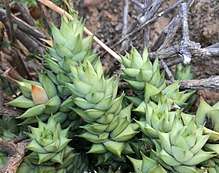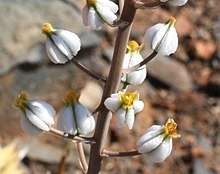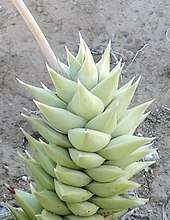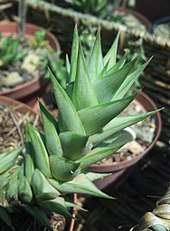Astroloba herrei
Astroloba herrei is a small succulent plant of the genus Astroloba, restricted to the area around the Swartberg mountains, South Africa.
| Astroloba herrei | |
|---|---|
 | |
| Astroloba herrei in habitat | |
| Scientific classification | |
| Kingdom: | Plantae |
| Clade: | Tracheophytes |
| Clade: | Angiosperms |
| Clade: | Monocots |
| Order: | Asparagales |
| Family: | Asphodelaceae |
| Subfamily: | Asphodeloideae |
| Genus: | Astroloba |
| Species: | A. herrei |
| Binomial name | |
| Astroloba herrei (L.) Uitewaal | |
| Synonyms | |
|
Astroloba dodsoniana Uitewaal | |
It is listed as a Vulnerable species on the Red List of the South African National Biodiversity Institute (SANBI).[1]
Description


Astroloba herrei is a compact Astroloba species, with stems growing up to 20 cm high, that are densely covered in pointed succulent leaves. Flowers appear from June to November.
With its sharp, grey-green, keeled leaves, and its puffed up, inflated flowers, the species is easily mistaken for the closely related Astroloba spiralis species. However it is genetically distinct and can always be distinguished by its flowers. Both spiralis and herrei have puffed up, inflated flowers, but those of herrei are smooth (unlike spiralis, which has a wrinkled, transversely rugose, perianth).

Other less reliable ways of identifying herrei are the fine, dark, longitudinal lines (striations) which are sometimes visible below the surface of the leaves, and the slight blueish colour which herrei attains in sheltered or shaded environments. Leaves often feature narrowly acuminate leaf tips that spread outwards more strongly than in spiralis. However these are not certain ways of identifying it; the only sure way of distinguishing this species with certainty is by its flowers.
A variety of this plant was formerly recognised as a separate species, Astroloba dodsoniana (Uitewaal). The dark longitudinal stripes of this variety of herrei are faint or even invisible, and the leaves are slightly paler. This is just a growth form and it can appear at random among normal herrei plants in all herrei populations.[2]
Distribution
This species has historically been considered rare, disjunct and restricted to small populations near Uniondale in the Little Karoo, and the widely separated Prince Albert in the Great Karoo. In 2017 its distribution was revised when it was found to be widespread in the more remote areas north of the Swartberg mountains.[3][4]
The species is listed as Vulnerable - partly because it was believed to have a very restricted range, and partly because it is threatened by habitat destruction and illegal collecting. In habitat, it grows on Karoo flats, often underneath bushes which provide it with some protection from the sun.[1][5]
References
- "Red List of South African plants: Astroloba herrei Uitewaal". SANBI.
- U. Eggli: Illustrated Handbook of Succulent Plants: Monocotyledons. Springer Science & Business Media, 2001. p.187.
- S. Molteno, G. Smith, E. Van Jaarsveld. (2017) Extending the Natural Distribution Range of Astroloba herrei Uitewaal (Asphodelaceae: Alooideae): Implications for Its Conservation Status. Haseltonia. pg(s) 39–47 ISSN 1938-2898
- GF. Smith, E. Figueiredo, S. Molteno (2018) Lectotypification of Astroloba herrei Uitewaal (Asphodelaceae: Alooideae). Bradleya 36, pg(s) 224-226
- S.Molteno (2018) Prince Albert's Astroloba. Haworthiad 32, 1. ISSN 1359-1614
External links
| Wikimedia Commons has media related to Astroloba herrei. |